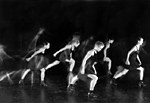The opening sequence of Pat Graney’s new work, Tattoo, is probably one of the most arresting in the piece—two naked women, tattooed, walk slowly and deliberately upstage past a landscape of bones and other fragments. At a recent rehearsal, the dancers were wearing their standard gear, a combination of Lycra and rags; the bones might be replaced with replicas made of ice, if a way can be found to keep them from melting and warping the floor. Even though Graney has been working on Tattoo for close to three years, still last-minute changes remain to be made.
Pat Graney Company
On the Boards/Behnke Center for Contemporary Performance
January 13-16, 21-23
From early pieces like Childrenz Museum, where performers hung upside down like bats, through the Esther Williams look-alikes of Pagan Love Song, Graney’s work has been full of striking visual images. She works almost like a collagist, piling picture on picture, then looking for movement within the tableaux. The kinetic impact of the works comes as much from Dadalike juxtapositions of the reasonable and the irrational as from actual movement sequences. At one point in this new dance, pounds of sand comes pouring down onto the stage like a desiccated waterfall and then are used to outline the grid of a chessboard for human playing pieces. What started as a natural event becomes a sophisticated game.
Graney’s very detailed gestural vocabulary is frequently drawn from commonplace tasks. In Tattoo, the dancers seem to be using an adding machine, shuffling cards, or applying makeup, while a disembodied voice recites a monologue about shoes or just free-associates (“tee, teapot, teeth”). The locomotor phrases are usually earthbound rather than flying and are performed with great concentration and a kind of sturdy determination. That attitude gives them a sense of importance beyond their technical challenge.
The surreal quality of the work is reinforced by Graney’s collaborators. Early contributions from ceramic artist Marilyn Lysohir include the opening image of the tattooed women in the boneyard. Costumer Frances Kenney has collected an amazing wardrobe of shoes, including ankle-twisting heels and pairs of impossibly tall platform boots that the dancers use like anchors in a counterbalancing sequence. A set of “electric skirts” by Ellen Fullman add an erratic percussion track to Amy Denio’s score. The accordion in Denio’s work gives a tango quality to the dancers’ striding and turning.
Graney has remarked that Tattoo is about the way in which our bodies are marked by our experiences—how our history is literally written in us. When you consider how physical rituals and habits reflect who we are, then indeed our selves are embedded in our muscles and bones.








